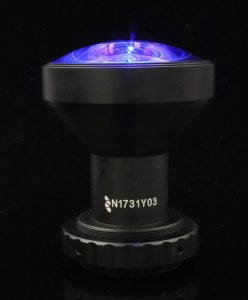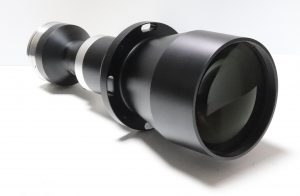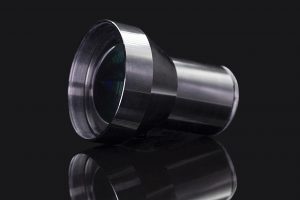Posted on: Monday, October 24th, 2022 In: Learning Optics with Austin
In this final post on types of lenses, we will be investigating fisheye, telecentric, and short-wave infrared (SWIR) lenses. The field of view for lenses is normally less than 60 degrees. The field of view for fisheye lenses, however, can go up to 175 degrees, which is very close to 180 degrees. Fisheye lenses are modeled after the actual eyes of a fish, and hence also where they get their name. If one looks at the eyes of the fish, they tend to bulge out, which is related to why the outermost fisheye lens is huge. Such a wide field of view is useful in security cameras where seeing the entire environment is needed. Fish probably have eyes with a wide field of view, so they are not eaten!

Telecentric lenses, contrary to the name, are not the lenses used in telescopes (in the “Focal Length and Applications of Lenses” post, we talked about how telescope lenses are composed of multiple different lenses). They are also not used in taking pictures. Rather, their application is in areas where the image size remains the same regardless of distance. Thus, the length of the pencil viewed through a telecentric lens will remain the same as the length of pencil in reality.

SWIR lenses have a cool application in being used in heat-detection cameras. This application results from the special property of infrared glass. Since regular lens material have a low transmission for infrared light (see “How Does Light Travel? Part I” on transmission), infrared glass is used to increase the transmission. SWIR lenses are used for light ranging from 0.9 to 1.7 um. As heat is a form of infrared light, SWIR lenses are used in appliances detecting heat.

As this is the 20th and final post, I want to thank all my readers for reading my blog posts. I also want to thank Glenn Brunelli, our Marketing Director for working with me to get the blog ready for publication every two weeks – it’s been a great experience! While this is where my lessons in optics come to an end, these lessons barely scratch the surface of optics (ha – get it?). While I hope this blog serves as a good introduction to optics, the more you get into the field, the more you realize there is a lot to learn! The Deep Dive into Optics blog will continue on with more advanced topics. The field of optics has so many applications in our lives, yet we may never realize it until we look at the image displayed from a fuzzy projector. Such is the behind-the-scenes importance of optics. May your study in light continue!
